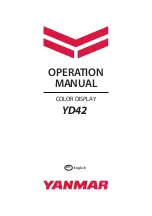
17
The shims may be made from aluminium plate wedges, simple flat
washers, or an angled wooden block. For thick shims, you may
need longer securing bolts than the M10 studding supplied, (
see
note in
Installing the Digital Radar Components on p.26
).
1.7 Cable requirements
This section provides details on selecting the appropriate cables for
your system. Permissible cable lengths depend on the digital radar
type and the boat’s power system. Information on the combined
inter-unit and power cables is provided in the following sections.
You need to consider the following before installing the cables:
•
You need to connect the digital radar to the SeaTalk
hs
switch, or
SeaTalk
hs
crossover coupler for data, and the Voltage Converter
Module (VCM100) unit for power. The cable required depends
on the distance between the digital radar, VCM100 and data
connections.
•
All cables should be adequately clamped and protected from
physical damage and exposure to heat - avoid running cables
through bilges or doorways, or close to moving or hot objects.
•
Acute bends in any cable must be avoided. Minimum bend
radius = 2.5 inch (60mm).
•
Where a cable passes through an exposed bulkhead or
deckhead, a watertight gland or
swan neck
tube should be used.
•
Do not cut and re-join cables.
Digital Radar cable
The digital radar cable combines inter-unit data (SeaTalk
hs
) and
power cores. One has a plug for connecting in to the SeaTalk
hs
network, the other is for connecting to the power output of the
VCM100 (
see Voltage Converter Module (VCM100)
on
page
). The
digital radar cable connector plug is situated at the rear of the digital
radar unit.
4 cable lengths and 2 extension cable length’s are available (
see
Table 1-1
p.18).
All figures are for cable lengths between digital radar to VCM100
and SeaTalk
hs
connections.
Summary of Contents for RA1048HD
Page 1: ...Digital Radar Scanners Installation Manual Document number 87087 1 Date June 2007...
Page 2: ......
Page 40: ...36...
Page 48: ...44...
















































